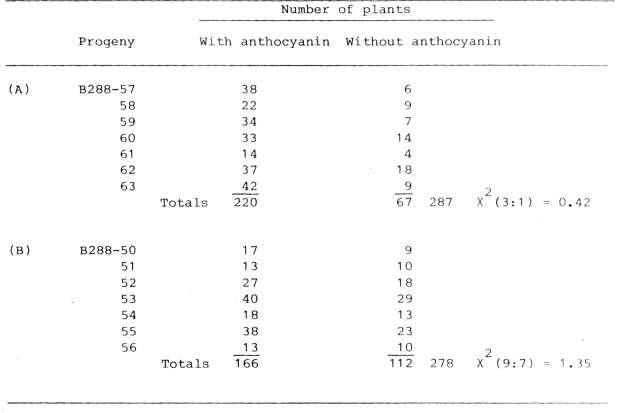A-2: A NEW LOCUS CONTROLLING ANTHOCYANIN PRODUCTION IN
PISUM
Marx, G.A. and N.F. Weeden
NYS Agricultural Experiment
Station
Geneva, NY 14456, USA
Muehlbauer, F.J.
USDA, Agricultural Research
Service
Pullman, WA 99164, USA
Blixt (1) has already pointed out
that most of the lines used for induced mutation studies are recessive at
the A locus. Only rarely have A lines been used. This imposes limits on
the potential mutation spectrum that can be observed after mutagenic
treatment. Recently, however, one of us (FJM) isolated a number of
anthocyanin pigmentation variants from "Melrose", a variety of so-called
Austrian Winter peas, the seeds of which had been exposed to a 0.5%
solution of Ethylmethane sulfonate for 2 hours prior to washing and
planting. The mutagen treated material used was kindly provided by D.L.
Auld of the University of Idaho. Included among the mutants was one in
which pigment was absent; thus, the phenotype appeared identical with that
conferred by a.
More recently still, another of us
(NFW) performed a small experiment which indicated that Muehlbauer's
mutant was a separate and distinct
mutation; i.e., involving a locus other than A. Further,
characterization of the mutant confirmed its similarity to a.
Flowers lack flavonoids, isoflavonoids and flavones as well as
anthocyanins (N.F. Weeden and G. Hrazdina, unpublished), and seeds exhibit
an increased susceptibility to Pythium infection relative to the
wild type line (N.F. Weeden and G.E. Harman, unpublished) just as a
plants are more susceptible than A plants.
Now additional evidence has been
added to the story. When the Muehlbauer mutant was crossed with a line of
genotype A the F1 possessed anthocyanin and the F2
segregated in accord with the ratio 3 anthocyanin present: 1 anthocyanin
absent (Table 1A). When the new anthocyaninless mutant was crossed with a
line of genotype a_ (anthocyaninless) the F1 possessed
anthocyanin and the F2 segregated in accord with the ratio 9
anthocyanin present: 7 anthocyanin absent (Table 1B). These results
indicate that the new mutant is monogenic recessive and non-allelic with
a. We designate the new mutant a-2 and name as type line D85-9. The
new mutant a-2 produces a phenotype morphologically identical wi'th
a (i.e., a-1) but the two
mutants reside at different loci.
Since the segregating populations in
these experiments involved other loci, some requiring anthocyanin
production for expression, and since these anthocyanin-dependent loci seem
to be equally inhibited by a-1 and a-2, the two loci appear to have
a similar function or be blocking the same
biosynthetic pathway. Still, more refined experiments are
required to demonstrate this conclusively.
